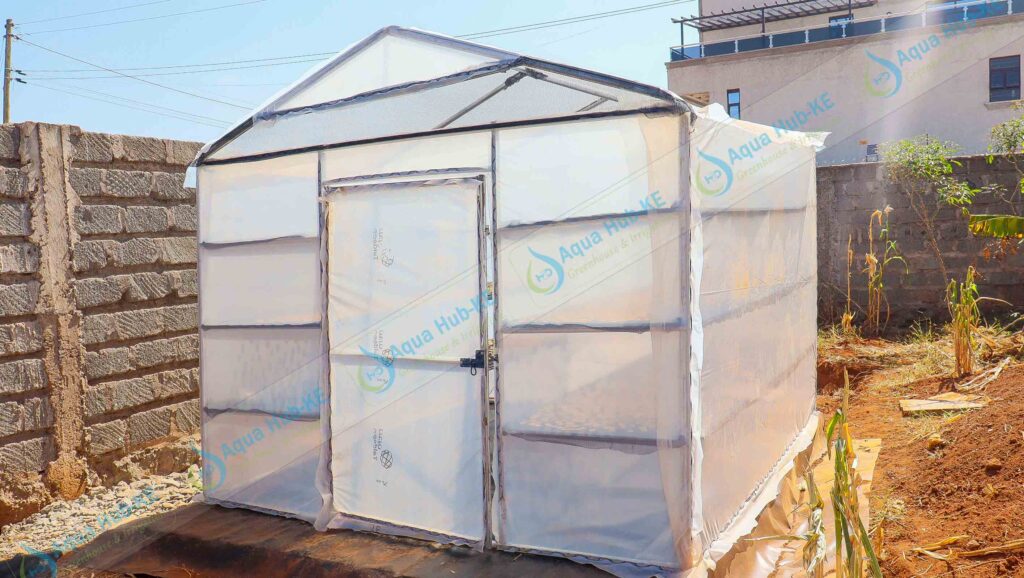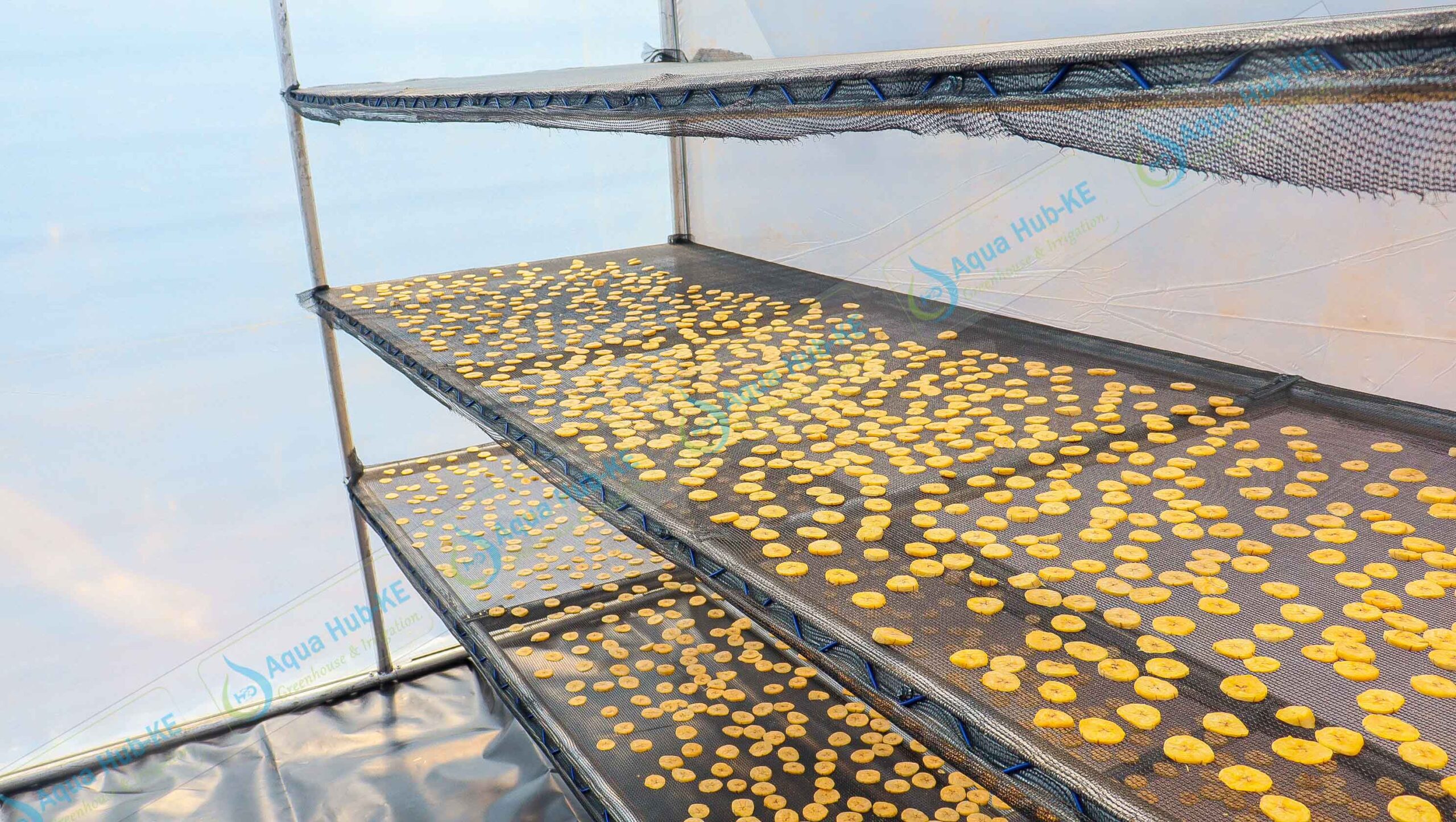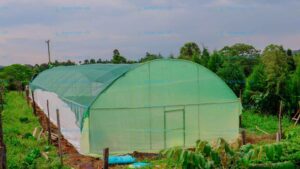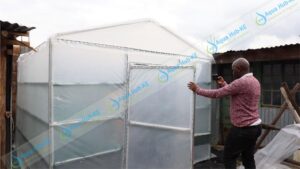Solar dryers are the top-quality food preservation structures that are widely becoming essential for farmers all over the world. The most prevalent challenge in farming is the post-harvest losses that often result from poor storage conditions. Use of solar dryers ensures that moisture is completely removed from drying products and increases the quality of life and shelf life.
Solar Dryers at Your Budget
For those in need of solar dryers or improved drying structures, Aqua Hub LTD is the company you would consider. We are popular for the design of simple hybrid solar dryers as per your budget and the drying capacity you want.
Call 0790719020
Solar Dryer Sizes and Drying Capacity
| Solar Dryer Size | Drying Capacity | Price of Solar Dryer |
| 2m x 3m x 2m | 80-100kgs | KES 90,000 |
| 2m x 4m x 2m | 90-110kgs | KES 110,000 |
| 2m x 5m x 2m | 100-130kgs | KES 130,000 |
| 8m x 15m x 2.2m | 2000 -2,200 kgs | KES 620,000 |
| 8m x 24m x 2.2m | 3,000 -3,500 kgs | KES 815,000 |
| 8mx 30m x 2.2 m | 5000 – 5,500 kgs | KES 880,000 |
Learn the type of Dryers we Construct

Simple Wooden Solar Dryers – type of solar dryer that uses direct drying mechanism to dry food substances. Direct drying is achieved by using transparent polythene material as the covering to allow sunlight inside the structure and retain the heat. The structure is designed with wooden frames to hold the cover, and shelves inside for placing the products to dry.
Tunnel Metallic Dryer – also uses a transparent polythene material to allow sunlight into the structure. Because of its insulation properties, it prevents heat loss. The structure is metallic jointed by prefabricated steel pipes. Profiles hold the polythene material. On the top or roof is ventilation, and fans allow air entry into the dryer.
Hybrid Solar Dryers – uses solar energy and additional sources such as charcoal burner, biomass and electric power to generate heat for drying food. The dryer is just a tunnel metallic structure connected to an external metallic furnace which directs heat on the inside drying chamber. Because of the extra heat from the additional energy sources, drying process is faster and more effective. Smart ventilators and air fans balance the drying conditions.
How do Solar Dryers Preserve Food?
The sunlight heats the air inside; it circulates over the produce and removes moisture through evaporation. Moisture evaporates as steam and is blown out through the ventilation by dry incoming air.
Hybrid dryers work by using air preheated by direct penetrating sunlight together with heat directed by the external furnace. This combined heat makes it more effective to remove moisture from high quantity of drying substance for a short time. Even without sunlight presence, the extra energy sources, biomass, charcoal or electricity are used to dehydrate food.
What Makes our Solar Dryers Ideal for Food Drying
Since our solar dryers are ideal for drying both harvested crops and food substances like meat and fish, we implement proper hygiene. We use non-corrosive polythene material to design our solar dryers to ensure no harmful chemicals. Because of their waterproof nature, the polythene cover protects harvest from humidity and fungal infections.
The metallic structures, shelves and wooden frames are anti-bacterial, non-corrosive and safe for handling food products.
Moreover, we recommend using disinfectants to wash hands before entering the solar dryer to avoid contaminating food.
Which Solar Dryer to Use?
It depends on the quantity and type of products you are drying. For products with high moisture content such as vegetables, tomato, and leafy greens, hybrid dryers are best. On the other hand, those products with low moisture content can be dried with direct solar dryers with simple design.
What to Consider when Choosing a Solar Dryer
Drying needs – as mentioned, you should consider the moisture level you want to achieve in your products.
Cost – the cost of the solar dryer is a subject of consideration as to whether you should acquire it.
Type of produce – crops that are perishable will require high control and highly ventilated dryers.
Capacity of produce – for high yields or commercial production you would want to do a large dryer or hybrid dryers. Small scale farmers would consider simple dryers.
Location – for hot areas, consider high ventilation and use UV treated polythene materials.
Climate – areas with poor drainage or waterlogged soil would require permanent structures like concrete surfaces.
Efficiency – choose efficient dryers that would match your production cycles.
Durability – always decide by considering how long a dryer would last before it gets faulty. Oten, wooden dryers would last for 3 years while metallic dryers would last for up to 10 years.
Practices for Safety and Effective Use of Solar Dryers
- Wash the drying chamber and dry the shelves using a dry clean towel.
- Clean the floor or surface insulation liner as well to remove dirt or bacteria.
- Always wash vegetables, fruits or other products that contain soil before drying.
- Leaves, fruits or tubers should be chopped into small chunks to reduce surface area for effective and fast drying.
- Remove maize cobs, chaff and dirt from grains before placing them onto drying shelves.
- Meat, fish, cassava, yams and arrowroots should also be cut into small sizes.
- The dryer should be closed and protected from unauthorized access.
Benefits of Solar Drying Harvested Produce
- Nutrient preservation: food dehydration by solar dryers only removes moisture and retains the essential nutrients.
- Improves shelf life: solar dryers’ lower moisture to optimal levels, thus no bacterial growth. Harvests will be kept in good condition for many days.
- Suitable for Versatile drying needs: you can use it to dry legumes, meat, cereals, coffee, tea, vegetables and many other harvests.
- Short drying duration takes minimum of 24 hours and maximum of 72 hours to dry substances.
- Value addition: drying sometimes improves the quality and taste because sorting and grading is involved. For example, drying meat and cassava can enhance better taste.
- Affordable: solar drying is one of the cheaper ways to dry high yields of produce. It costs way less compared to cabinets or electric dryers.
- Standards: by proper drying, your food products meet the export standards.
- Easier management and packaging: because of shelves, it is easier to remove chaff and dust from grains. Packaging or collection is also easier.
- Saves on Costs: Because solar energy is free and renewable you save on expenses that could have been spent on electricity.
- Dried products attract high prices: you can store cereals such as maize and sell them when the prices are high.





